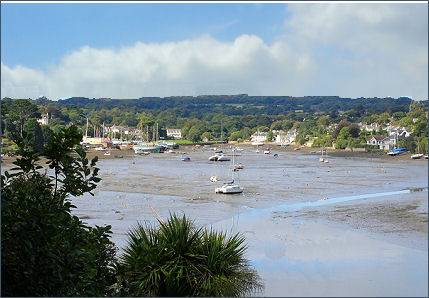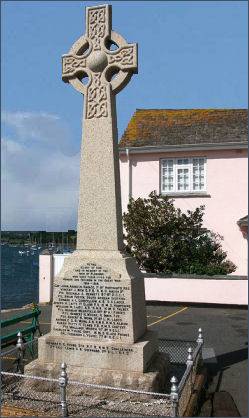Flushing
OS Grid ref:- SW 811 340
 The picturesque coastal village of Flushing lies at the foot of a steep hill, facing the bustling town of Falmouth across the Penryn River, an arm of the Carrick Roads. It is situated three miles east of Penryn and around ten miles to the south of the town of Truro.
The picturesque coastal village of Flushing lies at the foot of a steep hill, facing the bustling town of Falmouth across the Penryn River, an arm of the Carrick Roads. It is situated three miles east of Penryn and around ten miles to the south of the town of Truro.
Known in Cornish as Nanskersys, which means valley of the reed swamp, the village was founded in 1661, Flushing acquired its name from Dutch engineers from Flushing (Vlissingen) in the Netherlands who built the three main quays in the village.
The grand Queen Anne style houses on St Peter's Hill, the road that leads down into the village, were owned by captains of the packet ships that docked in nearby Falmouth. Admiral Lord Nelson once owned a house in St Peter's Road. The Spanish Armada intended to land at Flushing but was unable able to capture it.
 In the nineteenth and twentieth centuries, Flushing's economy was dependent mainly on fishing, the two farms and former manors of Trefusis (which was the original seat of the influential Cornish Trefusis family, Barons Clinton) and Tregew and on Falmouth Docks. A copper mine existed briefly on Jericho beach but extracting the copper proved commercially unviable.
In the nineteenth and twentieth centuries, Flushing's economy was dependent mainly on fishing, the two farms and former manors of Trefusis (which was the original seat of the influential Cornish Trefusis family, Barons Clinton) and Tregew and on Falmouth Docks. A copper mine existed briefly on Jericho beach but extracting the copper proved commercially unviable.
The village is today a centre for oyster fishing and recreational sailing. A passenger ferry operates a regular service between Flushing and Falmouth.
Due to its position, Flushing is said to be one of the warmest villages in Britain. The sandy beaches at Kiln are extremely popular in the summer months, particularly with tourists, and offer superb views of Falmouth Docks, the Carrick Roads and beautiful St Anthony's Head on the Roseland Peninsula.
There are two pubs in the village, the Royal Standard and the Seven Stars, which stands by the riverside. A bistro known as The Waterside is situated on the quay, there is also a seafood restaurant in Flushing, the Sticky Prawn.
The village church is dedicated to Saint Peter. It was built in the Norman style and was consecrated in August 1842. The building was renovated in 1871 by subscriptions, when a vestry was added. There is also a Methodist chapel on Kersey Road.
Flushing Regatta Week, a highly popular event, is held annually during late July or early August, the Regatta features water-based activities such as bathtub racing, rowing, swimming and sailing races, sand-castle building contests, a mini-marathon through the nearby village of Mylor and Flushing, an open-air church service, a pub quiz, crab catching, and a carnival on Saturday night.
A more recent annual event held in May is Flushing Arts Week, when the Village opens its doors to local artists and visitors for a Festival of Art.